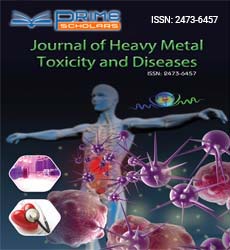Perspective - (2023) Volume 8, Issue 6
Clearing the Waters and Soil: Advanced Techniques for Heavy Metal Removal
Sha Zhin*
Department of Public Health, Anhui University, China
*Correspondence:
Sha Zhin,
Department of Public Health, Anhui University,
China,
Email:
Received: 29-Nov-2023, Manuscript No. ipjhmct-24-18970;
Editor assigned: 01-Dec-2023, Pre QC No. ipjhmct-24-18970 (PQ);
Reviewed: 15-Dec-2023, QC No. ipjhmct-24-18970;
Revised: 20-Dec-2023, Manuscript No. ipjhmct-24-18970 (R);
Published:
27-Dec-2023, DOI: 10.21767/2473-6457.23.6.52
Introduction
Heavy metal contamination in soil and water is a significant
environmental concern with far-reaching implications for
ecosystems and human health. Addressing this challenge requires
innovative techniques for efficient and sustainable removal of
heavy metals. This article explores cutting-edge methods that are
transforming the landscape of heavy metal remediation, offering
hope for the restoration of contaminated environments.
Description
Phytoremediation involves the use of plants to absorb,
accumulate, and sometimes transform heavy metals from the
soil or water. Certain plants, known as hyperaccumulators, have
the ability to tolerate and accumulate high concentrations of
metals. This eco-friendly approach not only reduces the need
for extensive excavation but also provides an aesthetically
pleasing solution. Researchers are exploring genetic engineering
to enhance the metal-accumulating capabilities of plants and
expand the range of contaminants that can be effectively
remediated. Chemical precipitation is a widely used method for
removing heavy metals from water. In this process, chemicals
are added to the water to form insoluble precipitates with the
heavy metals, which can then be easily separated. Common
precipitants include lime, ferric chloride, and sodium sulfide.
While effective, this method can alter the pH of the water and
may produce additional waste that requires proper disposal. Ion
exchange is a technique where ions in a solution are exchanged
for ions attached to a solid resin or other exchange media. This
method is particularly effective for removing heavy metal ions
from water. By selecting the appropriate exchange media, ion
exchange can target specific metals and achieve high removal
efficiency. However, the regeneration of the exchange media and
potential release of concentrated metal solutions are challenges
that need to be addressed. Adsorption involves the attachment
of heavy metal ions to the surface of a solid material, known as
an adsorbent. Activated carbon, zeolites, and various types of
clays are commonly used as adsorbents. This method is versatile
and can be applied to both soil and water remediation. Advances
in nanotechnology have led to the development of nano-sized
adsorbents with enhanced surface areas, increasing their
adsorption capacities. Electrokinetic soil remediation employs
the application of low-level electric currents to mobilize and
transport heavy metals in the soil. Electrodes are inserted into
the contaminated soil, creating an electric field that induces
the movement of ions. This method is particularly effective for
treating soils with low permeability, and it minimizes the need
for excavation. However, the energy consumption and potential
generation of harmful byproducts need careful consideration.
Reverse osmosis is a membrane-based separation process that
can effectively remove heavy metals from water. It works by
applying pressure to force water through a semi-permeable
membrane, leaving behind concentrated contaminants. Reverse
osmosis is widely used in water treatment plants and is capable
of removing a broad range of pollutants. However, the high
energy requirements and issues with membrane fouling are
challenges associated with this technique. Bioremediation
utilizes microorganisms to break down or transform heavy metals
in soil and water. Bacteria, fungi, and algae can be engineered
or selected for their metal-resistant and metal-transforming
capabilities. Microorganisms can either immobilize heavy metals
or convert them into less toxic forms.
Conclusion
The evolving landscape of heavy metal remediation is marked
by innovative and sustainable techniques that offer effective
solutions for cleaning up contaminated soil and water. As
researchers continue to refine these methods and address their
limitations, the hope is that these technologies will play a pivotal
role in restoring ecosystems, safeguarding water resources, and
ensuring a healthier environment for future generations. By
embracing these advanced techniques, we move closer to a world
where the detrimental impacts of heavy metal contamination are
mitigated, and the balance of our ecosystems is restored.
Citation: Zhin S (2023) Clearing the Waters and Soil: Advanced Techniques for Heavy Metal Removal. J Heavy Met Toxicity Dis. 08:52.
Copyright: © 2023 Zhin S. This is an open-access article distributed under the terms of the Creative Commons Attribution License, which permits unrestricted use, distribution, and reproduction in any medium, provided the original author and source are credited.

